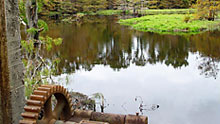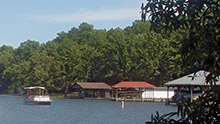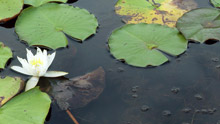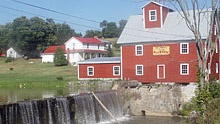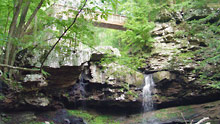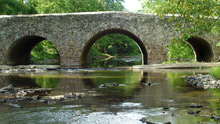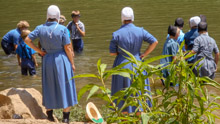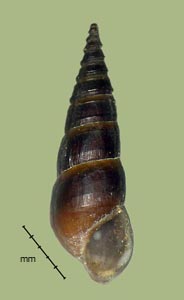Goniobasis or "Elimia arachnoidea, spinella, strigosa, striatula, etc.
> Habitat & Distribution
The range of Pleurocera troostiana was restricted by Goodrich (1940) to its type locality in Mossy Creek, Jefferson County, Tennessee. Our regional surveys suggest, however, that together with all its probable synonyms, subspecies, and variants, the P. troostiana (in its broadest sense) ranges from the Valley-and-Ridge province of SW Virginia and East Tennessee west through the Unglaciated Interior Low Plateau of Middle Tennessee and North Alabama, north into central Kentucky. We have records of P. troostiana (sl) from small streams across the entire Tennessee/Cumberland drainage into the Green and Tradewater River drainages of The Ohio.
The typical subspecies, P. troostiana troostiana, ranges from the Powell River of SW Virginia throughout East Tennessee to North Alabama, where it is replaced by populations of the subspecies perstriata in patchwork fashion. We are also aware of several populatons of P. troostiana bearing the typical shell morphology inhabiting tributaries of the upper Cumberland River in Campbell Co, TN.
Within this region P. troostiana troostiana primarily inhabits small, rich, hardwater creeks and springfed streams. Populations are also occasionally found in larger rivers when cool and clear, especially when spring sources are nearby. We have not been able to confirm populations of P. troostiana from Clinch River tributaries north of the Virginia line, nor reports of the species in Holston tribuataries around Gate City (Goodrich 1913). The FWGNA incidence rank for all four subspecies combined is I-5.
> Ecology & Life History
Bickel (1968) offered a very complete description of the habitat of central Kentucky P. troostiana populations (subspecies lyonii), which he said were "commonly found on firm surfaces in riffle areas but more abundant in shallow spots near shore where water is in motion although slow moving and less turbulent." Yes, that describes the habitat of typical P. troostiana troostiana populations exactly.
Bickel also focused a great deal of attention on egg masses, which he figured and described as "plano-convex, 1.3 - 2.0 mm in diameter, and partly covered with fine sand grains." He personally observed eggs "deposited on the undersides of stones" in the month of April, but quoted an unpublished Ph.D. dissertation by W. L. Minkley to the effect that egg masses could be found "July through September, as well as during October, January, and April."
Alas, Bickel did not offer any further observations on life history. But it seems reasonable to expect that two years will be required for maturity, and that several years of iteroparous reproduction can be expected thereafter, as is the case for pleurocerids generally (Dazo 1965). This is life cycle Hi of Dillon (2000: 156 - 162).
> Taxonomy & Systematics
In some of our prior publications (Stewart & Dillon 2004, Dillon & Robinson 2007a), as well as in previous versions of this website, we referred to this species as Pleurocera (or Goniobasis) arachnoidea (Anthony, 1854) - the oldest name available in the Virginia literature. The extension of the FWGNA survey into east Tennessee, however, uncovered a great number of synonyms for this species with older dates than Anthony's arachnoidea. These include strigosa (Lea 1841), teres (Lea 1841), and striatula/striata (Lea 1841), as well the subsequent rubella (Lea 1862), spinella (Lea 1862), porrecta (Lea 1863), and vittatella (Lea 1863). All these nomina are junior synonyms of Isaac Lea's troostiana. See my essays of 7Jan20, 10Dec24 and 14Jan25 for a complete review.
There is much confusion on the precise date of Lea's authorship of Melania troostiana, however - Burch (1989) and Graf (2001) giving 1838 and Tryon (1873) and Goodrich (1940) giving 1841. Lea apparently read his paper describing troostiana before the American Philosophical Society on November 4, 1836, Scudder (1885) asserts that Volume 6 of the Transactions (in which Lea's description was published) was printed and ready for publication in 1838, and the date on the front cover of Transactions Volume 6 (in which his description was published) states "1839." For a more complete discussion see my essay of November 2019 from the link below.
Three populations of P. troostiana (identified as G. arachnoidea) were included in the allozyme study of Dillon & Robinson (2007a). The species is quite distinct genetically. There is no evidence of hybridization with either P. simplex or P. clavaeformis, two other species of Pleurocera with which it often co-occurs in SW Virginia and Tennessee.
As the FWGNA project expanded into Middle Tennessee, North Alabama, and Kentucky, however, we discovered that populations of P. troostiana inhabiting streams west of Walden Ridge at Chattanooga often bear shells that are costate as well as striate. The appearance of costae on the shells of P. troostiana corresponds strikingly with the distribution of Pleurocera laqueata, a costate species which ranges as far east as Walden Ridge but no further. In my essay of 15Oct24 I presented shell-morphological evidence of troostiana/laqueata hybridization in a small tributary of the Cumberland River east of Nashville, and on 12Nov24 I generalized such findings across a wide variety of species and regions to suggest reticulate evolution in the North American Pleuroceridae. See links below.
For populations bearing lightly costate shells we have recognized at the subspecific level Pleurocera troostiana perstriata, for those bearing heavily costate shells P. troostiana edgariana, and for the variably-costate populations of Ohio tributaries in central Kentucky P. troostiana lyonii. A complete review of the elaborate taxonomy of Pleurocera troostiana is available for download here [pdf].
This species has traveled through three genera in thirty years. Although predominantly assigned to Goniobasis through most of the 20th century, in the 1980s many workers began placing it in the resurrected generic nomen, "Elimia." Both Goniobasis and Elimia were subsumed under Pleurocera by Dillon (2011). See my essay of 23Mar11 from the link below for more.
> Maps and Supplementary Resources
- Dillon, R. T., Jr. (2020) The four subspecies of Pleurocera troostiana (Lea 1838), with synonymy. FWGNA Circular 2: 1 -5. [pdf]
- Distribution of P. troostiana in the Tennessee/Cumberland (2022)
- Pretty photo of living P. troostiana troostiana,
courtesy of Chris Lukhaup.
> Essays
- Taxonomic controversy has surrounded the generic nomina Pleurocera, Goniobasis, and Elimia for many years. The best entry into the subject would be my essay of 23Mar11, entitled Goodbye Goniobasis, Farewell Elimia. Links are available from that essay to older resources.
- In my blog post of 4Aug19, "CPP Diary: Yankees at The Gap," I documented a striking case of cryptic phenotypic plasticity in the population of P. troostiana inhabiting a little stream that runs south out of Cumberland Gap, TN.
- I used the Melania troostiana situation as an example of why Isaac Lea Drives Me Nuts in November of 2019.
- The evidence that troostiana is the oldest available name for this entire far-flung and variable species was reviewed in 6Dec19, On the Trail of Professor Troost. That post includes a reproduction of Lea's original (1838) figure, as well as a couple recently collected topotypes.
- And I reviewed the evidence that teres (Lea 1841), strigosa (Lea 1841), arachnoidea (Anthony 1854), spinella (Lea 1862), striatula (Lea 1862), porrecta (Lea 1863) and vittatella (Lea 1863) are junior synonyms of troostiana (Lea 1838) in my post of 7Jan20, CPP Diary: The Many Faces of Professor Troost. That post includes reproductions of Lea's original (1843) figures of teres and strigosa, plus images of modern topotypes for spinella, porrecta/vittatella, strigosa and striatula.
- The subspecies perstriata was proposed in my essay of 15Apr20, Huntsville Hunt, and elaborated in my essay of 10May20, A House Divided.
- I treated the subspecies edgariana in my essay of 5June20, What is Melania edgariana?, and the subpecies lyonii in 6July20, The Return of Captain Lyon.
- In my essay of 15Oct24 I presented shell morphometric evidence that populations identified as P. troostiana perstriata result from Widespread hybridization between Pleurocera laqueata and P. troostiana in streams of the Tennessee/Cumberland. That essay also featured a nice map comparing the distributions of all four troostiana subspecies to that of P. laqueata.
- And in my follow-up essay of 12Nov24 I generalized evidence of such hybridization across a variety of species and regions to suggest Reticulate evolution in the North American Pleuroceridae.
- Given the levels of hybridization documented in the essays linked above, we should not be surprised to discover that a wonderful tower of taxonomic babel has been erected to capture the rich variety of shell morphological variation associated. See my review of 10Dec24, Taxonomy Part I, for a reprint of Anthony's (1854) original arachnoidea figure and and a modern image of the holotype. See my review of 14Jan25, Taxonomy Part 2, for Lea's original figures of porrecta, rubella, spinella, and striatula (striata), with modern images of the holotypes for all these, plus strigosa and teres as well.
> References
Anthony, J.G. (1854) Descriptions
of new fluviatile shells of the genus Melania Lam., from the western
states of North America. Annals of the Lyceum of Natural History
of New York 6: 80 -132.
Bickel, D.
(1968) Goniobasis curreyana lyoni,
a pleurocerid snail of west-central Kentucky. The Nautilus 82: 13 - 18.
Branson, B.A. (1987)
Keys to the aquatic gastropoda known from
Kentucky. Trans. Kentucky Acad. Sci. 48: 11 - 19.
Burch, J. B. (1989)
North American Freshwater Snails.
Malacological Publications, Hamburg, Michigan. 365
pp.
Dazo, B. C. (1965) The morphology and natural history of Pleurocera acuta
and Goniobasis livescens
(Gastropoda: Cerithiacea: Pleuroceridae). Malacologia 3: 1 -
80.
Dillon, R.
T., Jr. (1989) Karyotypic evolution in
pleurocerid snails: I. Genomic DNA estimated by flow cytometry.
Malacologia, 31: 197-203.
Dillon, R. T., Jr. (2000)
The Ecology of Freshwater Molluscs. Cambridge, Cambridge University
Press. 509 pp.
Dillon, R. T., Jr. (2011) Robust
shell phenotype is a local response to stream size in the genus Pleurocera
(Rafinesque, 1818). Malacologia 53: 265-277.
Dillon, R. T. Jr.,
& K. B. Davis (1991) The diatoms
ingested by freshwater snails: temporal, spatial, and interspecific
variation. Hydrobiologia 210: 233-242.
Dillon, R. T., Jr.,
& J. D. Robinson (2007a) The Goniobasis ("Elimia") of
southwest Virginia, I. Population genetic survey. Report to
the Virginia Division of Game & Inland Fisheries, 25
pp. [PDF]
Goodrich, C. (1913)
Spring collecting in southwest Virginia. Nautilus 27: 81-82,
91-95.
Goodrich, C. (1935)
Studies of the gastropod family Pleuroceridae V.
Occas. Pprs. Mus. Zool. Univ. Mich., 318: 1 - 12.
Goodrich, C. (1940)
The Pleuroceridae of the Ohio River drainage system. Occas.
Pprs. Mus. Zool. Univ. Mich., 417: 1-21.
Graf, D. L. (2001)
The cleansing of the Augean stables.
Walkerana 12(27): 1 - 124.
Jokinen, E.H. 1992. The Freshwater Snails (Mollusca:
Gastropoda) of New York State. NY State Mus Bull 482, Albany, New York.
Lea, Isaac (1838-39)
Description of New Freshwater and Land Shells. Transactions of
the American Philosophical Society (New Series) 6: 1 154.
Lea, Isaac (1841)
Continuation of Mr. Lea's paper on New Fresh Water and Land
Shells. Proceedings of the American Philosophical Society 2: 11
15.
Lea, Isaac (1843)
Description of New Fresh Water and Land Shells. Transactions of
the American Philosophical Society (New Series) 8: 163 250.
Lea, Isaac (1862) Description of a new genus (Goniobasis)
of the Family Melanidae and eighty-two new species. Proceedings of the
Academy of Natural Science of Philadelphia 19: 262 272.
Lea, Isaac (1863) New Melanidae of the United States. Journal of the Academy of Natural Sciences of Philadelphia (New Series) 5: 217 356.
Scudder, N. P. (1885)
Bibliographies of American naturalists - II. The published
writings of Isaac Lea, LL.D. Bullentin of the US National
Museum
23: 1 - 278.
Smith, D.G. 1980.
Goniobasis virginica
(Gastropoda: Pleuroceridae) in the Connecticut River USA. Nautilus
94:50-54.
Stewart, T. W., &
R. T. Dillon, Jr. (2004) Species
composition and geographic distribution of Virginia's freshwater
gastropod fauna: A review using historical records. Am.
Malac. Bull. 19: 79-91.
Tryon, G. W. (1873)
Land and Freshwater shells of North America Part IV,
Strepomatidae. Smithsonian Miscellaneous Collections 253: 1 -
435.

